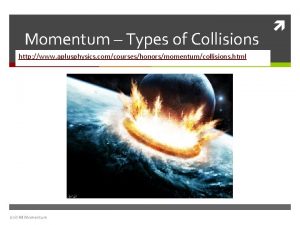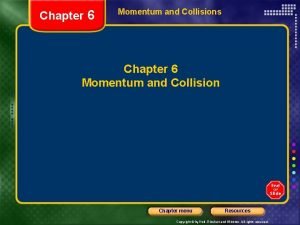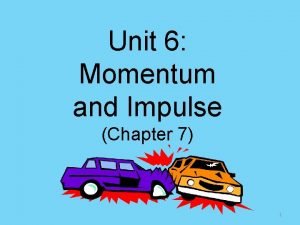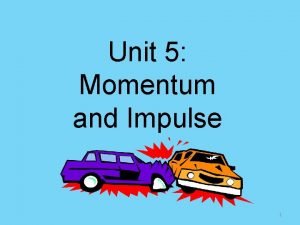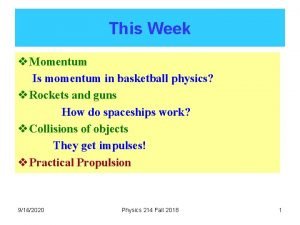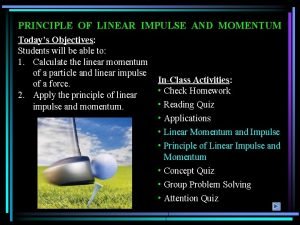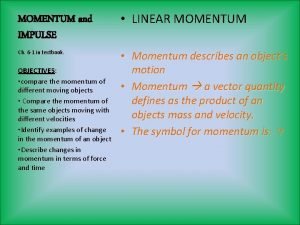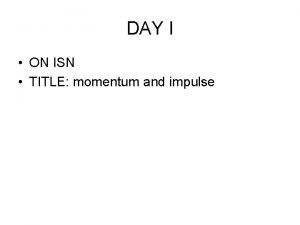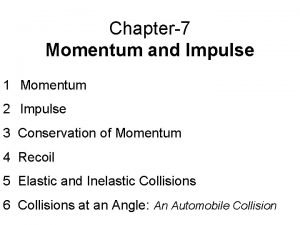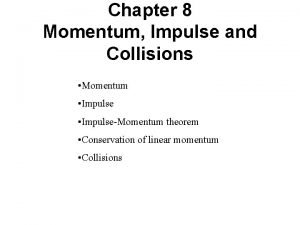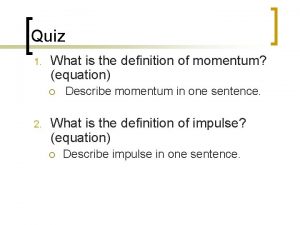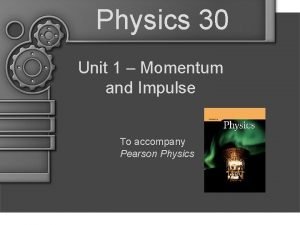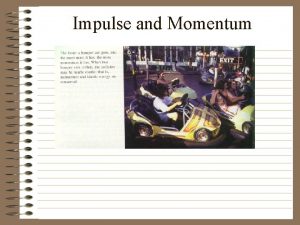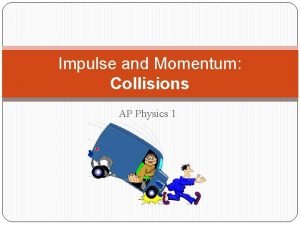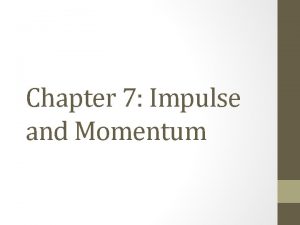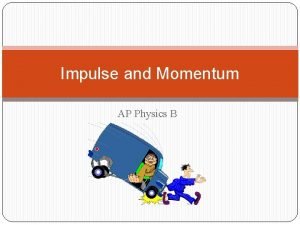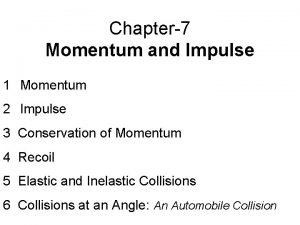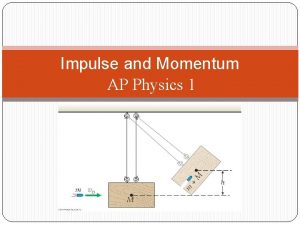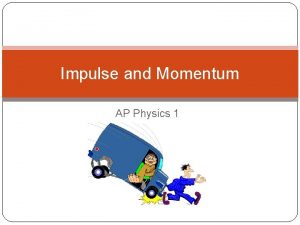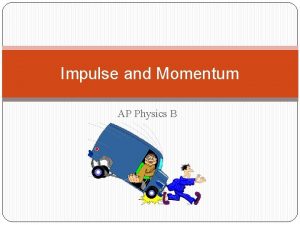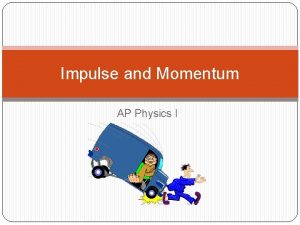Momentum and Collisions Momentum and Impulse p The




















- Slides: 20

Momentum and Collisions

Momentum and Impulse p The momentum of an object is the product of its mass and velocity: p=mv § Units of momentum: kg·m/s

Momentum and Impulse p If the resultant force F is zero, the momentum of the object does not change.

Impulse-Momentum Theory I = FΔt = Δp = mvf – mvi (I = Impulse) p *If we exert a force on an object for a time interval Δt, the effect of this force is to change the momentum of the object from some initial value mvi to some final value mvf.

Example: A golf ball of mass 50. g is struck with a club. Assume that the ball leaves the club face with a velocity of +44 m/s. A) Estimate the impulse due to the collision. B) Estimate the length of time of the collision and the average force on the ball. pi = mvi = 0 (ball starts at rest) pf = mvf = (0. 05 kg)(44 m/s) pf = 2. 2 kg·m/s Impulse = Δp = pf – pi Δp = 2. 2 kg·m/s - 0 kg·m/s Δp = 2. 2 kg·m/s

Example: A golf ball of mass 50. g is struck with a club. Assume that the ball leaves the club face with a velocity of +44 m/s. A) Estimate the impulse due to the collision. B) Estimate the length of time of the collision and the average force on the ball. p Estimate distance ball travels while in contact with club = displacement of ball while in contact ≈ 2. 0 cm

momentum theory: FDt = mvf mvi Follow through in golf swing, batting, tennis. p Catching a water balloon. p Moving with the punch in boxing. p Padding boxing gloves, goalie gloves in hockey, baseball mitts, inside of helmets… p

Example: In a crash test, a car of mass 1500 kg collides with a wall. The initial velocity of the car is 15. 0 m/s east and the final velocity of the car is 2. 6 m/s west. The collision lasts for 0. 150 s. find (A) How can the car’s initial velocity be to the east and its final velocity to the west? Calculate (B) the impulse due to the collision and (C) the average force exerted on the car.

In a crash test, a car of mass 1500 kg collides with a wall. The initial velocity of the car is 15. 0 m/s east and the final velocity of the car is 2. 6 m/s west. The collision lasts for 0. 150 s. find (A) How can the car’s initial velocity be to the east and its final velocity to the west? Calculate (B) the impulse due to the collision and (C) the average force exerted on the car. Example: pi = mvi pi = (1500 kg)(-15 m/s) = -2. 25 x 104 kg·m/s pf = mvf pf = (1500 kg)(2. 6 m/s) = +3. 90 x 103 kg·m/s I = Δp = pf – pi I = 3900 – (-22500) I = 2. 6 x 104 kg·m/s

Example: In a crash test, a car of mass 1500 kg collides with a wall. The initial velocity of the car is 15. 0 m/s east and the final velocity of the car is 2. 6 m/s west. The collision lasts for 0. 150 s. find (A) How can the car’s initial velocity be to the east and its final velocity to the west? Calculate (B) the impulse due to the collision and (C) the average force exerted on the car.

Rebounding mvi p FDt = mvf - Is it better to bounce or to hit and stick/stop?

Conservation of Momentum pi = p f p Law of conservation of momentum: when no external forces act on a system consisting of 2 objects, the total momentum of the system before the collision is equal to the total momentum of the system after the collision.

Example: A baseball player uses a pitching machine to help him improve his batting average. He places the 50. -kg machine on a frozen pond. The machine fires a 0. 15 -kg baseball with a speed of 36 m/s in the horizontal direction. What is the recoil velocity of the machine?

Example: A baseball player uses a pitching machine to help him improve his batting average. He places the 50. -kg machine on a frozen pond. The machine fires a 0. 15 -kg baseball with a speed of 36 m/s in the horizontal direction. What is the recoil velocity of the machine? pbefore = pafter m 1 v 1 i + m 2 v 2 i = m 1 v 1 f + m 2 v 2 f (+50. kg 0. 15 kg)(0) = (50. kg)(v 1 f) + (. 15 kg)(36 m/s) 0 = (50. kg)(v 1 f) + (. 15 kg)(36 m/s) (50. kg)(v 1 f) = -5. 4 kg·m/s v 1 f = -0. 11 m/s (moves. 11 m/s opposite to the motion of the ball)

Collisions p For any type of collision, the total momentum is conserved. p However, the total kinetic energy is generally NOT conserved.

Elastic Collisions p p Elastic collisions: both momentum and kinetic energy are conserved. Example: two balls bouncing perfectly off each other. m 1 v 1 i + m 2 v 2 i = m 1 v 1 f + m 2 v 2 f and ½ m 1 v 1 i 2 + ½ m 2 v 2 i 2 = ½ m 1 v 1 f 2 + ½ m 2 v 2 f 2

Inelastic Collisions p Inelastic collisions: momentum is conserved, but kinetic energy is not. n When 2 objects collide and stick together, the collision is PERFECTLY INELASTIC; in this case, their final velocities are the same. For perfectly inelastic collisions, m 1 v 1 i + m 2 v 2 i = (m 1 + m 2)v 2 f

Example: A large luxury car with a mass of 1800. kg stopped at a traffic light is struck from the rear by a compact car with a mass of 900. kg. The two cars become entangled as a result of the collision. If the compact car was moving at 20. 0 m/s before the collision, what is the velocity of the entangled mass after the collision?

Example: A large luxury car with a mass of 1800. kg stopped at a traffic light is struck from the rear by a compact car with a mass of 900. kg. The two cars become entangled as a result of the collision. If the compact car was moving at 20. 0 m/s before the collision, what is the velocity of the entangled mass after the collision? pbefore = pafter M 1 v 1 i + m 2 v 2 i = (m 1+m 2)vf (1800 kg)(0) + (900. kg)(20. 0 m/s) = (1800+900)vf 1. 80 x 104 kg·m/s = (2700)vf 1. 80 x 104 = (2700)vf v 1 f = 6. 67 m/s

Example: Two kids are playing marbles. The shooter rolls toward a stationary marble at 5. 0 cm/s. They two collide and the smaller marble speeds away at 8. 0 cm/s. What is the final velocity of the shooter? Assume the shooter is three times as massive as the smaller marble. (have faith with the masses…) pi = p f 3 mvsi + mvmi = 3 mvsf + mvmf 3 m(5. 0 cm/s) + 0 = 3 mvsf + m(8. 0 cm/s) 15 cm/s + 0 = 3 vsf + 8. 0 cm/s 7 cm/s = 3 vsf Vsf = 2. 3 cm/s
 Aplusphysics momentum-conservation answer key
Aplusphysics momentum-conservation answer key Types of collisions
Types of collisions A moderate force will break an egg
A moderate force will break an egg Formula for inelastic collision
Formula for inelastic collision Chapter 6 momentum and collisions
Chapter 6 momentum and collisions Momentum is conserved in all collisions
Momentum is conserved in all collisions Physics 03-06 impulse and momentum answer key
Physics 03-06 impulse and momentum answer key Unit 6 momentum and impulse
Unit 6 momentum and impulse Units of momentum
Units of momentum Momentum in basketball physics
Momentum in basketball physics Principle of linear impulse and momentum
Principle of linear impulse and momentum Linear impulse and momentum
Linear impulse and momentum Importance of momentum and impulse
Importance of momentum and impulse Poem about momentum and impulse
Poem about momentum and impulse How does impulse relate to momentum
How does impulse relate to momentum Importance of momentum and impulse
Importance of momentum and impulse Impulse momentum
Impulse momentum Si unit of impulse
Si unit of impulse Units for momentum
Units for momentum Momentum and impulse quiz
Momentum and impulse quiz Physics 30 momentum and impulse unit exam
Physics 30 momentum and impulse unit exam
